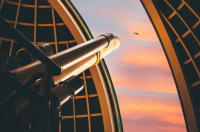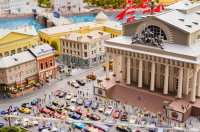Historywise, this place boasts the title of Russia’s first museum. Established in 1714 by the country’s most famous (and eccentric) emperor, Peter the Great, it is still considered a part of the Academy of Sciences, and can well be called Russia’s first attempt at science communication. Most of its objects were brought by expeditions to faraway lands, which made it really popular during the pre-information age and can still attract those who are interested in ethnography or simply enjoy cultural oddities.
Still, when I see people making their way to this museum’s entrance, I know that it’s not the Indian idols or Mongolian tableware that most of them have come for. What they are really after is a single room at the museum’s far end, the one which gives the place its most commonly used name: the Kunstkamera.
This small chamber hosts the museum’s very first collection: items brought by Peter the First from his journeys to Europe. This Cabinet of Curiosities (which was the common name for such places) displays exhibits most startling and grotesque. Apart from different 18th-century surgical tools (Peter had a great many interests, dentistry included, and enjoyed pulling teeth of friends and servants) and taxidermied animals, its real “jewel” is a great number of embryology, human anatomy and teratology specimens: a whole freak show of vats with Siamese twins, cyclopes, malformed organs and such.
As disturbing as they might seem, Kunstkamera’s exhibits are definitely unique, and can well give you the idea of what science was once like: most of them were bought from prominent scientists of their time. In a sense, the Cabinets of Curiosities were a way of promoting science, and a dispassionate viewer can notice lots of peculiar details that show the scientists’ way of showing concern for their audience, like decorating amputated limbs with lace doilies or adding flowers into vats with human fetuses. Still, as they say, viewer discretion is advised: though I’ve never considered myself a faint-hearted person, I am somewhat afraid of having nightmares every time I visit the place.
Despite the anatomical artifacts being Kunstkamera’s most famous exhibits, the museum also has other scientific relics that are by no means less interesting: the First Astronomical Observatory of the Academy of Sciences and the Gottorp Globe, a unique 17th-century planetarium and a true marvel of early mechanical engineering. Unfortunately, you can see those only as part of a guided tour, so it’s best to check the schedule on the museum’s website, which has a decent English version where you can find lots of information about its history and current events.
To sum up, Kunstkamera is a place that you’ll definitely remember - though I can’t really guarantee that you’ll like it. Still, if it is new experiences that you’re looking for, this particular place will definitely make your day!




